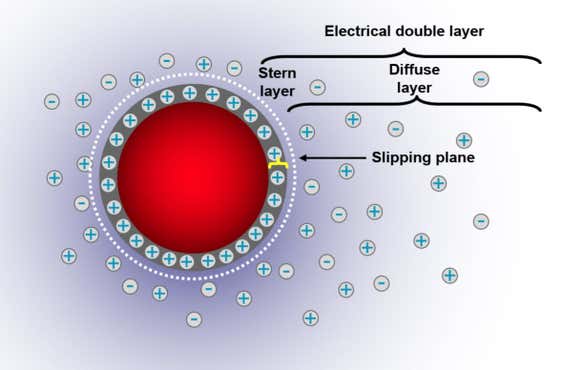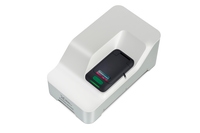Zeta potential measurements to improve formulation stability, shelf life and reduce formulation time and costs
Zeta potential (or Electrokinetic potential) is a measure of the magnitude of the electrostatic repulsion/attraction between particles and is one of the fundamental parameters known to affect stability of dispersed systems. Its measurement brings detailed insight into the causes of dispersion, aggregation or flocculation, and can be applied to improve the formulation of dispersions, emulsions and suspensions.
When we measure zeta potential, we are measuring the electrical potential at the slipping plane of a particulate system.
A charged particle will attract counter-ions which become more diffuse the further from the particle surface. Those counter-ions that travel with the particle define the slipping plane and its associated zeta potential.
Zeta potential is not a property of the particle but of the system, that is the particle and the medium it is dispersed in. Changes to the medium, such as concentration of ions, types of ions and pH will all affect the zeta potential.

Measuring zeta potential is essential for understanding the behavior of colloidal systems. Zeta potential analyzers, such as the Zetasizer Advance, utilize a technique called electrophoretic light scattering (sometimes known as laser Doppler velocimetry) to determine the zeta potential of a wide range of colloidal and dispersed systems, such as metal oxides, proteins, liposomes, emulsions and so on.
The zeta potential of colloidal dispersions influences various properties, including stability, rheology, and interactions with other molecules or surfaces. Understanding and controlling zeta potential is crucial in diverse applications such as drug delivery, food processing and coating formulations. As a rule of thumb the zeta potential value measured can be broadly classified in terms of the magnitude of the charge (see table). Notice that we have used +/- as it is the magnitude and not the sign that contributes to stability, though most systems tend to be negatively charged.
| Zeta Potential (mV) | Stability |
|---|---|
| 0 to ±10 | Highly unstable - rapid coagulation/flocculation |
| ±10 to 20 | Limited stability |
| ± 20 to 30 | Moderately stable |
| > ± 30 | Highly stable |
The importance of this measurement type lies in its ability to predict and control the stability and performance of colloidal dispersions. By optimizing zeta potential, manufacturers can enhance product quality, shelf life and overall process efficiency.
Zeta potential analysis is widely used across different industries where colloidal systems play a significant role. These industries include pharmaceuticals & medicine, cosmetics, food & beverages, paints & coatings and many others.
In each of these sectors, understanding and controlling zeta potential is crucial for optimizing product formulations, ensuring stability, and enhancing performance.
Zeta potential analysis is vital in pharmaceutical formulations to assess the stability of drug suspensions, emulsions and liposomes.
It helps in optimizing drug delivery systems by controlling particle interactions and ensuring uniform dispersion.
In the cosmetics industry, zeta potential measurement aids in formulating stable emulsions, creams and lotions.
It ensures the uniform distribution of active ingredients and prevents phase separation or creaming, thereby enhancing product efficacy and shelf life.
Zeta potential analysis is essential in food and beverage formulations to stabilize emulsions, suspensions, and colloidal systems.
It helps control the texture, mouthfeel, and appearance of food products, as well as preventing sedimentation and creaming during storage.
In paints and coatings, zeta potential measurement influences dispersion stability, pigment distribution, and film formation.
It ensures uniform color, adhesion, and durability of coatings, contributing to their performance and longevity.

Light Scattering for every application
Malvern Panalytical offers a range of leading zeta potential analyzers for the measurement of zeta potential, or electrophoretic mobility.
The Zetasizer Advance range provides a simple, fast and accurate way to measure zeta potential in either laboratory or process environments and a variety of cell types, including affordable disposable folded capillary cells.
The Zetasizer range incorporates state-of-the-art technologies and advanced features to deliver precise and reliable measurements.
Key capabilities include:
For more information on zeta potential analyzer prices, read our 'how much does a zeta potential analyzer cost' page. You can also discover our solution portfolio in the table below.

Zetasizer UltraWorld’s most advanced light scattering system |

Zetasizer ProHigh performance, versatile and robust |

Zetasizer LabClassic side scatter particle size and zeta potential analyzer with enhanced capabilities |
|
|---|---|---|---|
| Measurement type | |||
| Zeta potential | |||
| Technology | |||
| Dynamic Light Scattering | |||
| Electrophoretic Light Scattering | |||
| Environment | |||
| Environment | Lab - bench | Lab - bench | Lab - bench |